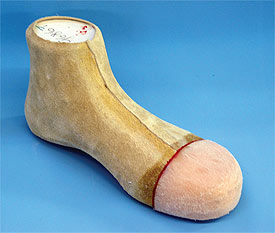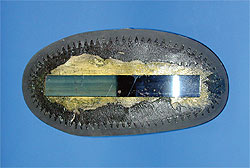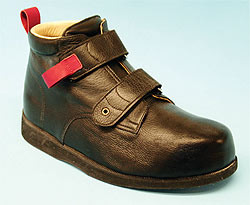When ordering custom shoes, enhancements can be requested to meet the requirements of patients with unique needs.
The implementation of the Therapeutic Shoe Bill (TSB) in 1993 opened up a marketing opportunity for extra-depth shoe manufacturers to provide non-custom shoe solutions for many patients. Shoes with multiple removable inlays, expandable uppers, and generous last designs make it far easier to properly fit and protect the “at-risk” foot. However, not all patients can be accommodated with an off-the-shelf product, so there is still a need for O&P professionals to provide well-fabricated, custom therapeutic shoes.
Many of the custom-molded shoes prescribed and fitted today are suited to particular populations. The typical presentation of a custom-shoe wearer includes some form of deformity due to edema, amputation, Charcot breakdown, or some combination of the three. Often, neuropathy is present, and with it the danger of skin breakdown and ulceration. A significant number of these patients have diabetes as a contributing factor, and many are geriatric.
These patients frequently require unique features and designs to ensure that the custom shoes provide further benefits and full protection. In addition, some custom-shoe wearers do not fit the presentations outlined above. Traumatic amputees, post-polio patients, AFO wearers, and pediatric cases each bring specific requirements. To address some of these needs, enhancements can be requested when ordering custom shoes.
Safety Toe Box
One question that I am frequently asked is, “Can you make a pair of custom-molded shoes with a safety toe box?”
Today, Occupational Safety and Health Administration (OSHA) regulations or specific workplace requirements may stipulate that workers must wear protective shoes. The adoption of these rules, along with the prevalence of diabetes and other debilitating foot conditions, sometimes results in a practitioner seeking a custom-molded shoe with a safety toe box.
 |
| Thermoplastic safety toe box over leather lining on modified shoe last. |
The standard safety toe box is made from steel. Steel toe boxes can be bought separately in regular sizes and added over the last of any custom shoe. However, patients who require custom-molded shoes usually have irregularly shaped feet. Although steel toes can be worked (i.e. hammered) to shape and fit, I am reluctant to use them for molded shoes because many patients who need them have some neuropathy. An ill-fitting steel toe box would quickly ulcerate a hammered digit or a prominent bunion.
In order to get a closer fit, I prefer to use a firm thermoplastic. The plaster shoe lasts can be shaped appropriately for the patient’s feet, and then a heated plastic, such as 4mm Subortholen® or Co-poly, can be precisely vacuum-formed for it. Once cooled, the proximal edges can be feathered to eliminate any rough junctions.
Custom-formed thermoplastic toe boxes will hold up to a lot of abuse and ensure a more intimate fit. We have used them for all kinds of industrial workers as well as for farmers and hunters. A well-constructed thermoplastic toe box will fully protect the foot from external hazards and the shoe’s interior.
Sole Stiffeners
There are several indications for sole stiffeners in a shoe. We recommend steel shanks any time the patient has a transmetatarsal or more proximal amputation. The stiffener prevents extreme dorsiflexion of the added filler block into the distal foot during toe-off, when the shoe midsole flexes. Usually toe fillers for single or lesser digits do not require a shank.
 |
| Spring steel sole stiffener. |
Patients with callusing or delicate healing tissue on the plantar forefoot may also benefit from stiffeners. A rigid-soled shoe will not bend and therefore will reduce peak pressure in the forefoot region during third rocker.
Met-head fractures, hallux limitus, or turf toe often require restricted range of motion at the met heads. The insertion of a carbon footplate under a shoe’s insole will limit flexion. This is a good alternative to cementing a permanent steel shank into the shoe’s midsole because the plate is transferable between shoes, and because it’s removable when the condition heals. The thin plates are low bulk and lightweight and can be used in conjunction with custom foot orthotics when necessary. They also have a beneficial energy-return component when the plate springs back into shape at toe-off.
Rocker soles should always be requested when any form of stiffener is employed, otherwise natural gait may be impeded. We find that a chukka-boot height works best, as a stiffened sole lends itself to heel slippage in a low-top. Similarly, stiff-soled shoes can generate the feeling of sliding inside the shoe, so a secure lace closure is preferred to Velcro®.
Insole Materials
Given that the majority of custom-shoe wearers have diabetes, the industry-standard insoles are often constructed from Plastazote®. Plastazote’s chemical properties are described as a closed-cell, cross-linked polyethylene foam-which is a fancy way of saying that it will permanently deform when repetitive pressure is applied. This is an excellent attribute when dealing with sensitive and delicate feet. Plastazote comes in a variety of durometers and thicknesses. As the patient walks on the insole, a softer Plastazote top layer will quickly mold and compress at the high-pressure points. This automatically relieves areas of potential irritation. In addition, Plastazote is a relatively low-friction material, which reduces shear and the potential for additional skin breakdown.
Insoles provided under the Medicare TSB program, whether for custom or off-the-shelf shoes, must be (1) multi-density, (2) heat moldable, and (3) have a base layer that meets minimum standards for thickness and durometer. (Author’s note: For a fuller outline of the TSB requirements and billing guidelines, visit www.cms.hhs.gov/home/medicare.asp) All fabricators of insoles for the program must also have Pricing Data Analysis and Coding Contractor (PDAC, formerly SADMERC) approval before you can bill either the A-5512 or A-5513 codes. The Product Classification List of approved fabricators can be found at www.dmepdac.com
The primary advantage of Plastazote is its ability to deform; this is also its chief weakness. Some patients do not need the protection, and others will wear out the material very quickly. Patients who are heavier (more than 200 lb.), very active, or non-diabetic will require firmer and more durable insoles. Other EVA foams and cork come in a range of densities and are great alternatives to work with. All of these materials are thermoformable and relatively lightweight, yet they hold their shape and provide good support and control if necessary. Internal heel lifts are often fabricated using cork or EVA. Similarly, you can request hard-wearing top covers such as cloud, leather, or Spenco® for custom insoles.
 |
| Chukka boot with pull loops, shown in red for emphasis, and grommet. |
Closures/Straps
Some patients have difficulty donning their own shoes. This may be due to factors such as poor manual dexterity or obesity. You can request that pull-loops be sewn onto the ends of Velcro straps, tongues, and the backstrap of any shoe. Brass grommets on the ends of straps can be helpful for patients who use button hooks. Like those with surgical openings, these shoes may look more “orthopedic,” but often a caregiver who assists in dressing the patient will be delighted with the enhancement. To prevent the tongue sliding during gait, the lab can tack-stitch one side of the tongue to the upper to hold it in place. This somewhat restricts the throat opening of the shoe and should not be done if the patient wears an AFO. Alternately, the laces or Velcro can be slid through a small piece of leather sewn onto the tongue to prevent the tongue from slipping.




















